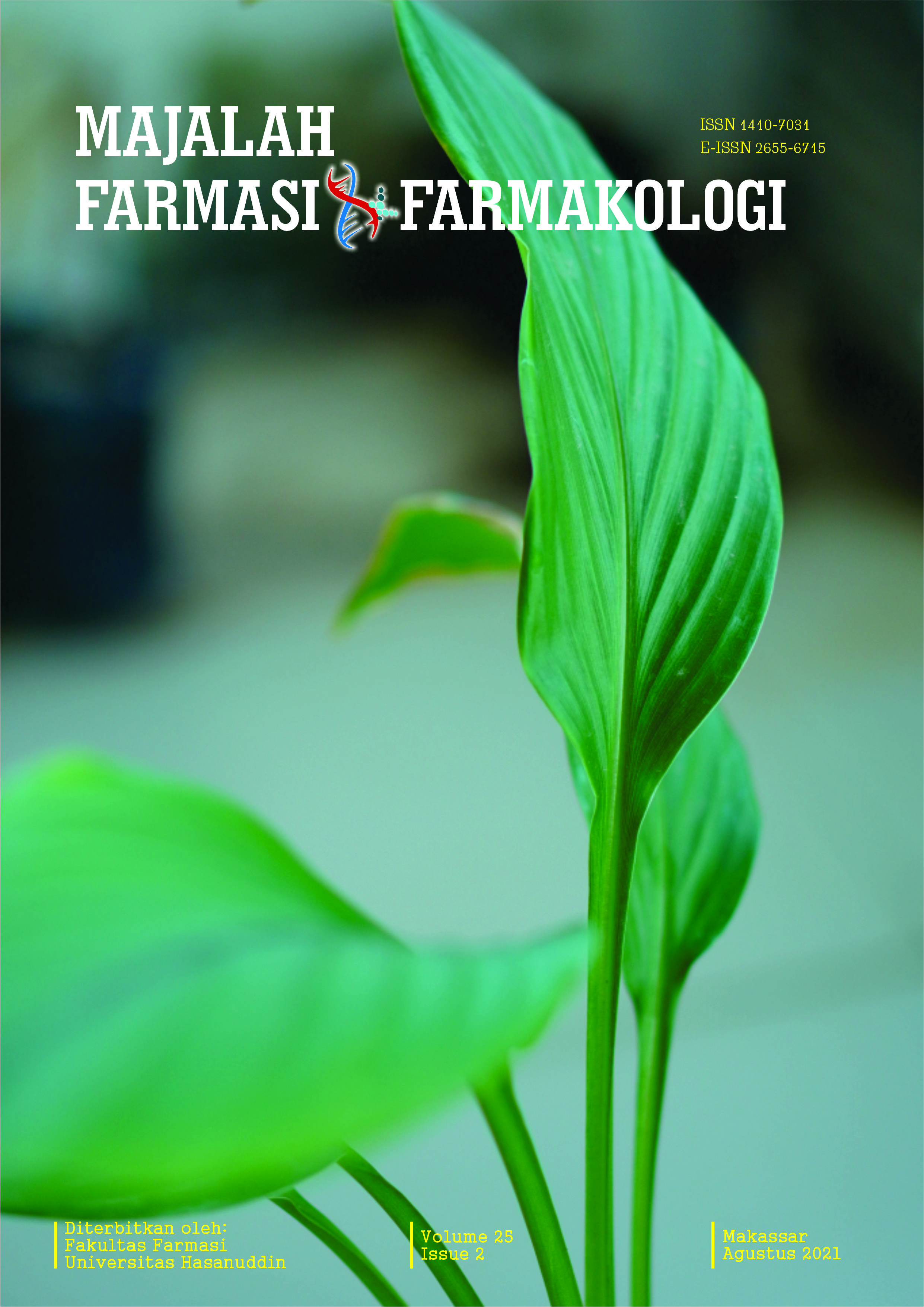PENGARUH KONSENTRASI EKSTRAK PROPOLIS DALAM SEDIAAN SALEP TERHADAP PENGHAMBATAN PERTUMBUHAN BAKTERI Staphylococcus aureus.
Abstract
Propolis adalah resin alami yang dikumpulkan oleh lebah madu dari tumbuhan dan digunakan secara luas dalam pengobatan tradisional. Sifat antibakteri dan antijamur dari ekstrak propolis telah diselidiki secara ekstensif, namun belum diketahui konsentrasi efektif propolis untuk diformulasikan sebagai salep antibakteri terhadap Staphylococcus aureus. Penelitian ini bertujuan untuk menentukan konsentrasi efektif ekstrak propolis dalam sediaan salep untuk menghambat pertumbuhan Staphylococcus aureus. Pengujian aktivitas antimikroba dilakukan dengan metode difusi menggunakan kertas cakram dengan masa inkubasi 24 jam. Diameter hambatan yang terbentuk diukur dan dianalisis secara statistik menggunakan metode Rancangan Acak Lengkap (RAL). Hasil penelitian menunjukkan diameter hambatan rata-rata salep propolis 1% sebesar 9,5 mm, 5% sebesar 9,7 mm, 10% sebesar 10,8 mm, dan kontrol positif sebesar 15,5 mm. Hasil analisis statistik nilai F hitung (36,6) > F tabel pada taraf 1% (7,591) dan 5% (4,006), sehingga menunjukkan ada pengaruh variasi konsentrasi ekstrak propolis pada sediaan salep terhadap luas diameter hambatan pada taraf 1% dan 5%. Disimpulkan bahwa konsentrasi yang efektif ekstrak propolis dalam sediaan salep dalam menghambat pertumbuhan Staphylococcus aureus adalah 1%.
References
Murlistyarini S, Prawitasari S, Setyowatie L, editors. Intisari Ilmu Kesehatan Kulit dan Kelamin. Universitas Brawijaya Press; 2018 Jan 31.
Zain DM. Formulasi Krim Antibakteri dengan Kombinasi Ekstrak Propolis Lebah Lokal (Trigona spp) dan Jeruk Nipis (Citrus aurantifolia Swingle). Bandung: Fakultas Matematika dan Ilmu Pengetahuan Alam, Universitas Islam Bandung. 2012.
Oklia S. Efek Antimikroba Ekstrak Propolis dari Lebah Madu (Apis mellifera) Sebagai Penghambat Pembentukan Biofilm Staphylococcus aureus secara in vitro (Doctoral dissertation, Universitas Brawijaya). 2018.
Ramadhiyanti F. Efek Antimikroba Ekstrak Propolis Lebah Madu (Trigona spp.) sebagai Penghambat Pembentukan Biofilm Staphylococcus aureus secara In Vitro (Doctoral dissertation, Universitas Brawijaya). 2018.
Boisard S, Le Ray AM, Landreau A, Kempf M, Cassisa V, Flurin C, Richomme P. Antifungal and antibacterial metabolites from a French poplar type propolis. Evidence-Based Complementary and Alternative Medicine. 2015 Jan 1;2015.
Chen YW, Ye SR, Ting C, Yu YH. Antibacterial activity of propolins from Taiwanese green propolis. Journal of food and drug analysis. 2018 Apr 1;26(2):761-8.
Siregar HC, Fuah AM, Octavianty Y. Propolis; madu multikhasiat. Penebar Swadaya Grup; 2011.
Suranto A. Dahsyatnya Propolis untuk menggempur penyakit. AgroMedia; 2010.
Trubus R. Propolis dari Lebah Tanpa Sengat Cara Ternak dan Olah. Jakarta: PT Trubus Swadaya. 2010.
Sun C, Wu Z, Wang Z, Zhang H. Effect of ethanol/water solvents on phenolic profiles and antioxidant properties of Beijing propolis extracts. Evidence-Based Complementary and Alternative Medicine. 2015 Jan 1;2015.
Downloads
Published
Issue
Section
License
Copyright (c) 2021 Majalah Farmasi dan Farmakologi

This work is licensed under a Creative Commons Attribution-NonCommercial 4.0 International License.
The copyright to this article is transferred to Universitas Hasanuddin (UNHAS) if and when the article is accepted for publication. The undersigned hereby transfers all rights in and to the paper including without limitation all copyrights to UNHAS. The undersigned hereby represents and warrants that the paper is original and that he/she is the author of the paper, except for material that is clearly identified as to its original source, with permission notices from the copyright owners where required. The undersigned represents that he/she has the power and authority to make and execute this assignment.
We declare that:
- This paper has not been published in the same form elsewhere.
- It will not be submitted anywhere else for publication prior to acceptance/rejection by this Journal.
- A copyright permission is obtained for materials published elsewhere and which require this permission for reproduction.
Furthermore, I/We hereby transfer the unlimited rights of publication of the above-mentioned paper in whole to UNHAS The copyright transfer covers the exclusive right to reproduce and distribute the article, including reprints, translations, photographic reproductions, microform, electronic form (offline, online) or any other reproductions of similar nature.
The corresponding author signs for and accepts responsibility for releasing this material on behalf of any and all co-authors. This agreement is to be signed by at least one of the authors who have obtained the assent of the co-author(s) where applicable. After submission of this agreement signed by the corresponding author, changes of authorship or in the order of the authors listed will not be accepted.


